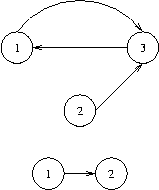poj 2553 The Bottom of a Graph【强连通分量求汇点个数】
2015-10-07 21:28
435 查看
The Bottom of a Graph
Description
We will use the following (standard) definitions from graph theory. Let V be a nonempty and finite set, its elements being called vertices (or nodes). Let E be a subset of the Cartesian product V×V, its elements being called edges. Then G=(V,E) is called a directed graph.
Let n be a positive integer, and let p=(e1,...,en) be a sequence of length n of edges ei∈E such that ei=(vi,vi+1) for a sequence of vertices (v1,...,vn+1). Then p is called a path from vertex v1 to vertex vn+1 in Gand we say that vn+1 is reachable from v1, writing (v1→vn+1).
Here are some new definitions. A node v in a graph G=(V,E) is called a sink, if for every node w in G that is reachable from v, v is also reachable from w. The bottom of a graph is the subset of all nodes that are sinks, i.e., bottom(G)={v∈V|∀w∈V:(v→w)⇒(w→v)}. You have to calculate the bottom of certain graphs.
Input
The input contains several test cases, each of which corresponds to a directed graph G. Each test case starts with an integer number v, denoting the number of vertices of G=(V,E), where the vertices will be identified by the integer numbers in the set V={1,...,v}. You may assume that 1<=v<=5000. That is followed by a non-negative integer e and, thereafter, e pairs of vertex identifiers v1,w1,...,ve,we with the meaning that (vi,wi)∈E. There are no edges other than specified by these pairs. The last test case is followed by a zero.
Output
For each test case output the bottom of the specified graph on a single line. To this end, print the numbers of all nodes that are sinks in sorted order separated by a single space character. If the bottom is empty, print an empty line.

Sample Input
Sample Output
| Time Limit: 3000MS | Memory Limit: 65536K | |
| Total Submissions: 9641 | Accepted: 4008 |
We will use the following (standard) definitions from graph theory. Let V be a nonempty and finite set, its elements being called vertices (or nodes). Let E be a subset of the Cartesian product V×V, its elements being called edges. Then G=(V,E) is called a directed graph.
Let n be a positive integer, and let p=(e1,...,en) be a sequence of length n of edges ei∈E such that ei=(vi,vi+1) for a sequence of vertices (v1,...,vn+1). Then p is called a path from vertex v1 to vertex vn+1 in Gand we say that vn+1 is reachable from v1, writing (v1→vn+1).
Here are some new definitions. A node v in a graph G=(V,E) is called a sink, if for every node w in G that is reachable from v, v is also reachable from w. The bottom of a graph is the subset of all nodes that are sinks, i.e., bottom(G)={v∈V|∀w∈V:(v→w)⇒(w→v)}. You have to calculate the bottom of certain graphs.
Input
The input contains several test cases, each of which corresponds to a directed graph G. Each test case starts with an integer number v, denoting the number of vertices of G=(V,E), where the vertices will be identified by the integer numbers in the set V={1,...,v}. You may assume that 1<=v<=5000. That is followed by a non-negative integer e and, thereafter, e pairs of vertex identifiers v1,w1,...,ve,we with the meaning that (vi,wi)∈E. There are no edges other than specified by these pairs. The last test case is followed by a zero.
Output
For each test case output the bottom of the specified graph on a single line. To this end, print the numbers of all nodes that are sinks in sorted order separated by a single space character. If the bottom is empty, print an empty line.

Sample Input
3 3 1 3 2 3 3 1 2 1 1 2 0
Sample Output
1 3 2
定义:点v是汇点须满足 --- 对图中任意点u,若v可以到达u则必有u到v的路径;若v不可以到达u,则u到v的路径可有可无。
题意:在n个点m条边的有向图里面,问有多少个点是汇点。
分析:首先若SCC里面有一个点不是汇点,那么它们全不是汇点,反之也如此。这也就意味着一个SCC里面的点要么全是,要么全不是。在求出SCC并缩点后,任一个编号为A的SCC若存在指向编号为B的SCC的边,那么它里面所有点必不是汇点(因为编号为B的SCC不可能存在指向编号为A的SCC的边)。若编号为A的SCC没有到达其他SCC的路径,那么该SCC里面所有点必是汇点。因此判断的关键在于SCC的出度是否为0.
思路:先用tarjan求出所有SCC,然后缩点后找出所有出度为0的SCC,并用数字存储点,升序排列后输出。
#include<stdio.h>
#include<string.h>
#include<vector>
#include<stack>
#include<algorithm>
#define MAX 21000
#define INF 0x3f3f3f
using namespace std;
int cost[MAX];
int low[MAX],dfn[MAX];
int head[MAX],instack[MAX];
int ans,n,m;
int sccno[MAX],clock;//sccno用来记录当前点属于哪个scc,
int scccnt;//记录总共有多少个scc
stack<int>s;
vector<int>newmap[MAX];//scc缩点之后储存新图
vector<int>scc[MAX];//用来记录scc中的点
int out[MAX];//记录scc的入度
int ant[MAX];
struct node
{
int beg,end,next;
}edge[MAX];
void init()
{
memset(head,-1,sizeof(head));
ans=0;
}
void add(int u,int v)
{
edge[ans].beg=u;
edge[ans].end=v;
edge[ans].next=head[u];
head[u]=ans++;
}
void getmap()
{
int i,j,a,b;
for(i=1;i<=m;i++)
{
scanf("%d%d",&a,&b);
add(a,b);
}
}
void tarjan(int u)
{
int v,i,j;
low[u]=dfn[u]=++clock;
s.push(u);
instack[u]=1;
for(i=head[u];i!=-1;i=edge[i].next)
{
v=edge[i].end;
if(!dfn[v])
{
tarjan(v);
low[u]=min(low[u],low[v]);
}
else if(instack[v])
low[u]=min(low[u],dfn[v]);
}
if(low[u]==dfn[u])
{
scccnt++;
scc[scccnt].clear();//??
while(1)
{
v=s.top();
s.pop();
instack[v]=0;
sccno[v]=scccnt;
scc[scccnt].push_back(v);
if(v==u)
break;
}
}
}
void find(int l,int r)
{
memset(low,0,sizeof(low));
memset(dfn,0,sizeof(dfn));
memset(sccno,0,sizeof(sccno));
memset(instack,0,sizeof(instack));
clock=scccnt=0;
for(int i=l;i<=r;i++)
{
if(!dfn[i])
tarjan(i);
}
}
void suodian()
{
int i,j;
for(i=1;i<=scccnt;i++)
{
newmap[i].clear();
out[i]=0;
}
for(i=0;i<ans;i++)//遍历所有的边
{
int u=sccno[edge[i].beg];//当前边的起点
int v=sccno[edge[i].end];//当前边的终点
if(u!=v)//因为sccno中记录的是当前点属于哪个scc,所以u!=v证明不在同一个scc但是由一条边相连,
{ //证明这两个scc联通
newmap[u].push_back(v);//将scc中的点储存下来 ??
out[u]++;//两个scc联通 则入度加一,
}
}
}
void solve()
{
int i,j,k=0;
for(i=1;i<=scccnt;i++)
{
if(out[i]==0)
{
for(j=0;j<scc[i].size();j++)
ant[k++]=scc[i][j];
}
}
sort(ant,ant+k);
for(i=0;i<k;i++)
{
if(i<k-1)
printf("%d ",ant[i]);
else
printf("%d",ant[i]);
}
printf("\n");
}
int main()
{
int j,i;
while(scanf("%d",&n),n)
{
scanf("%d",&m);
init();
getmap();
find(1,n);
suodian();
solve();
}
return 0;
}相关文章推荐
- NOIP2001 Car的旅行路线
- PopupWindow全解析
- 自定义Toast布局
- 分布式消息系统:Kafka
- ISLR系列:(4.2)模型选择 Ridge Regression & the Lasso
- linux下汇编学习笔记[第一天]
- 远程登录数据库
- SPOJ-2
- NOIP2001 统计单词个数
- 《数学之美》之计算复杂度
- 【读书笔记】oracle闪回技术
- nyoj 拦截导弹 79 (转换为LIS)
- 求平均成绩
- VoltDB可以借鉴的文章
- 数组中的逆序对数(C++版)
- 连载《一个程序猿的生命周期》- 34、8个月无果而终,离职前的思考
- Android 防止锁屏后调用onDestroy()方法
- NOIP2001 数的划分
- File存储—外部存储
- C语言字符串那些事
